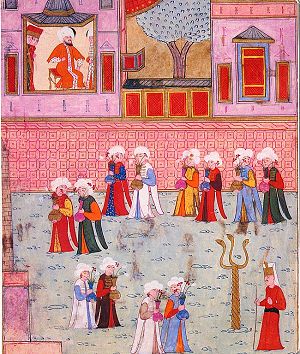My Name is Red By Orhan Pamuk

Literature │ A Sacred Path
My Name is Red by Orhan Pamuk
(published in “Avrupa” newspaper)
(Picture: From The Book of Festivities by Surname-I Hümayun)
Pamuk invites us into the sacred world of miniaturists, a world in which, through drawing and seeing with the inner eye, leads one onto the path to god, and a world in which physical blindness towards the end of one’s life is seen (pardon the pun) as a gift from god, and if this blindness is not granted, then, as seen with Master Osman, master of the miniaturist guild, one takes it upon themselves to reach such illumination, with a needle. Each chapter is depicted from a different character; from the murdered miniaturist, to the dog, tree, golden coin, and the devil depicted in the paintings created by the miniaturist. With each distinctive voice, we are plunged into a world seeped in strange goings on, and murder.
Murder is the key driving force for this novel, at first, one may think that this is going to be a flat, ineffective story, told through many points of view which will only go over one’s head, but it rapidly turns into a traditional murder mystery and if we are truly going to be rather technical and ridiculously boring, the book should in fact be found under the crime section and not the general fiction section. As Pamuk pulls together the multiple frayed threads, he immediately pulls them apart again, but it is absolutely clear that as soon as one strips away the layers of morality and story-telling, the true essence of the novel lays within the mystery of who is murdering the miniaturists one by one.
Pamuk tries to orchestrate the life of the miniaturist, their history as classic guilders and craftsmen who’s style were changing, and the morality in being effected by the west, and Frankish manners, it is about trying so very desperately hard to preserve a period of time and style which was slipping away gradually, yet at an alarming speed, this strong sense of hopelessness is so imminent, that murder is the only way of stopping it.
Pamuk’s description of colour and imagery permeates the black and white pages that the reader’s eyes are so intently focused on, at first we are thankful for being permitted into a world of a long ago art, however, towards the end of the novel, one can sense that Pamuk is being swallowed whole by the images and stories that he is re-telling. There are many points throughout the novel in which a few lines of description would suffice rather than pages and pages of description which will only be retold yet again, sometimes this method is pleasing as we are given the foresight into one story through another’s eyes. This novel shows Pamuk’s love for traditional tales, ones of treachery, love, hate, battles and jealousy and one can not help but to feel that he himself wishes that he was able to create such stories, the only problem is that they have already been written.
Just as with Dan Brown’s The Da Vinci Code Pamuk uses his murder mystery to manipulate the reader, and as much as many readers out there enjoy being pulled this way, then that, it all depends on who is doing the pulling and swaying, and there is something unsettling about Pamuk’s writing which depicts a strange twisted sense of joy in watching us squirm, yet one reads on, but ought to be aware of this. To add to this strange mix of tossing, turning and squirming, Pamuk writes with a distinguishable sense of melancholy, the sadness of loss, the pains and excitement of torture and other strange forms of relishing in the pursuit of a happiness that can never truly be met. However, after the tiring and assaulting journey that one sets out on with this novel, one is able to yet again learn about a world, albeit probably not completely accurate, that one had not considered in the past, and it is an intriguing one.
©Zehra Mustafa

-
-
-
-
/ 0 Comments